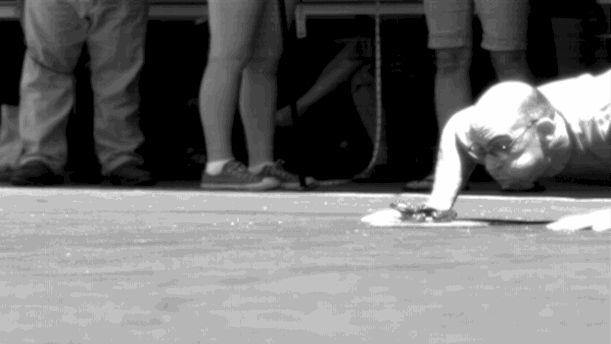The Science of Winning Leaps at the Calaveras County Frog Jumping Competition
Biologists visited the world-famous frog jubilee to study the amphibians’ record-breaking jumps and the frog jockeys’ expert techniques
/https://tf-cmsv2-smithsonianmag-media.s3.amazonaws.com/filer/20131016053201frog-jumping.jpg)
Most scientists conduct their research in a lab, or by working with calculations or simulations on computers. Some engage in field work, perhaps observing animals in the wild or excavating fossils.
Then, there’s the team of biologists from Brown University led by Henry Astley that studies the movement of animals and has been conducting some science in a decidedly less conventional atmosphere. Recently, they traveled to the Calaveras County Jumping Frog Jubilee in Angels Camp, California—the county made famous by Mark Twain’s 1865 short story—to film and analyze 3124 of the jumps and try to figure out exactly how the bullfrogs in the competition jump so far.
A team of biologists recently visited the world-famous Calaveras County Jumping Frog Jubilee to study the amphibians’ record-breaking leaps and the frog jockeys’ expert techniques. All images courtesy of Roberts Lab/Brown University
The idea originated, they say, with the realization that expert frog “jockeys” (annual competitors that bring their own frogs and urge them to jump with special techniques) were far better than scientists at getting the animals to clear vast distances: The longest bullfrog jump ever recorded in a lab was 4.26 feet, while frogs at the competition surpassed that figure regularly, at times jumping 6 or 7 feet.
To figure out how this was possible—in terms of biomechanics, muscle strength and other limits of physiology—the group traveled to the competition, documenting their results in a paper published today in the Journal of Experimental Biology. They caught on camera bullfrogs jumping as far as 7.2 feet, and calculated that the frogs beat the lab record of 4.26 feet 58 percent of the time.
How do these superlative bullfrogs do it? The data indicated that apparently, the jockeys’ strange-looking approach to motivating the frogs really does make a huge difference.
Jockeys take their craft seriously—beyond the $50 prize for breaking the world record, there are the immense bragging rights of winning the world’s foremost frog-jumping competition, which attracts thousands of entrants annually and dates to 1893. These jockeys, the authors write, “bring their own locally-caught frogs and are serious competitors, often working in family groups that have passed down frog jumping secrets through generations of competition.”
The rules dictate that each competitor’s frog is allowed three jumps in a row, and the distance of each jump is combined for the total score. The current record, set in 1986 by “Rosie the Ribiter” and jockey Lee Giudici, is 21 feet, 5 3/4 inches: 7.16 feet per jump. On average, the scientists observed that at the recent Jubilee, the jockeys’ frogs jumped nearly 5 feet per attempt.
But the researchers were gratified to find that they weren’t alone in being outclassed by the jockeys. The Jubilee’s “rental” frogs—which are available for amateurs to rent so they can enter the competition themselves—only averaged 3.6 feet per jump, similar to those in the lab.
Part of the explanation for this discrepancy was made apparent in the scientists’ calculations, which they made after they digitized each filmed jump so they could conduct a detailed analysis. These showed that, compared to rental frogs, the jockeys’ had a greater take-off velocity, jumped at a higher angle compared to the ground and performed more work with their leg muscles as they sprang off the ground.
What’s the underlying reason for this superior performance, though? The jockeys are required to use the exact same species of frogs as the amateurs, and the researchers reported that, outwardly, they didn’t look all that different.
They surmised that the difference was what Astley calls “the will of the jockey.” He explains, in a press statement: “The frog senses whether you are a scientist hoping it’s going to jump well, or a deadly reptilian-like predator who is going to eat it.”
To resemble this deadly predator, jockeys follow a ritualized strategy that’s been honed over the past few decades. Crouching, they rub the frogs’ hind legs, then drop them a short distance to the ground. A moment after the frog lands, they chase after it head-first, either shouting at it or blowing at it from behind. Apparently, this behavior powerfully triggers the frogs’ flight instincts, leading them to jump the greatest possible distance.
For the researchers, this led to an interesting question: Do the Jubilee-winning 7-foot jumps represent the pinnacle of sheer bullfrog ability? Their theoretical calculations, based on our knowledge of the frogs’ muscle strength, energy, jump velocity and angle, indicate that the answer is yes—the frogs probably can’t jump any farther than this length.
This answer is supported by historical trends in the competition. For the first few decades in which figures were kept, the record repeatedly shot up by leaps and bounds, going from roughly 12 feet (for 3 combined jumps) in 1930 to nearly 17 feet in 1953 to 20 feet in 1976. Since then, it’s been relatively stagnant, only creeping past 21 feet in 1986 and remaining unbroken in the years since.
This sort of trend indicates that jockeys figured out the best method by trial-and-error, then hit the bullfrogs’ physiological wall—and that when it comes to frog-jumping Jubilees, it’s jockeys, not frogs, that win championships.
/https://tf-cmsv2-smithsonianmag-media.s3.amazonaws.com/accounts/headshot/joseph-stromberg-240.jpg)

/https://tf-cmsv2-smithsonianmag-media.s3.amazonaws.com/accounts/headshot/joseph-stromberg-240.jpg)